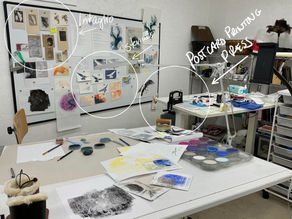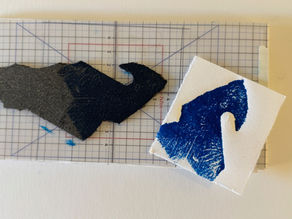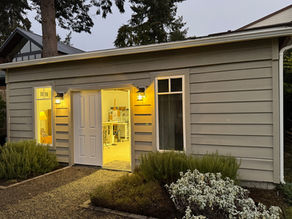Where do visual stories come from?
- Caroline Clarke

- Mar 26, 2024
- 2 min read

As illustrators, we often start with words. We read the text for the moments that stand out — for an evocative scene, a dramatic turn of the story, a moment of tension or character.
We brainstorm with words and then with images. One thumbnail may spark an idea for another. Concepts may merge. We design by finding the right division of space, value structure and visual elements to make a point. Words are eventually left behind and the intention and the picture evolve together.
Story doesn’t always start with words though. Sometimes story starts while making a picture — and trying things. Value choices set a mood. Color choices set a story direction. Figure and ground choices set surprising plot twists.
I started this week’s work in the studio with the simple intention of exploring different materials and techniques — a brayer and black paint, monotypes and pan pastels to make an elephant. I was looking forward to the dark darks, textures and beautiful line qualities you can get.
But it was story that I found.

This monotype of the elephant went down lighter than I expected. A mid-tone, then. Magenta and purple for the elephant gave me some darks, but a purple elephant? OK, a relatively “light” story then (The Purple Cow, by Gelett Burgess, anybody?). Added script in the background to evoke spoken words or song. As the yellow pan pastels mixed with the paint though, they took on a grubbier tone. Graffiti?
About now, I imagine you’re wondering why the “bandaid” or X over the elephants head? It started with an irreparable screw-up of the eye, so in frustration I taped over the head. That’s when the story of the illegal trade in elephant tusks appeared and changed everything.
I went back to the script. The grubbiness began to mean something now. Magenta evolved into orange, on its way towards red. A cacophony of voices in languages I couldn’t understand all focused on the elephant.
Then I stood up. That was enough for this exploration. To take this story further I’d have to thumbnail some ideas, bringing the visual choices that had spoken to me here. Shape that background grubbiness into something a little more recognizable, like the continent of Africa perhaps.
So where do visual stories come from?
This time, the nub of this particular visual story came through trying something and then trying the next something. Not the way to illustrate on a deadline of course, but great for tuning into one’s imagination.
A closer look:

My model is the African Bush Elephant (Loxodonta africana) in the Natural History Museum in DC. He’s part of the Museum’s permanent collection and has been in the entry rotunda since 1959.
I’ve sat at his feet with my sketchbook on a number of occasions.
He’s big — 13 feet tall and weighs 11 tons. The information desk includes info on, among other things, the threat of poaching elephant tusks.
On that subject, the book Poached: Inside the Dark World of Wildlife Trafficking by the science journalist, Rachel Love Nuwer (2018), is an informative read.

























I'm always interested in a book on a subject I know nothing about. Poached:........ tweaked my interest. Thanks...